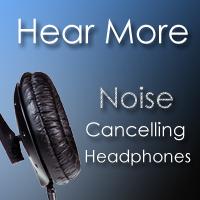
Someday, I hope portable music lovers figure it out... you don't have to settle for the crappy headphones that came with your player! In the world of headphones, you can do much, much better. At the very least, a ten to twenty dollar pair of headphones is a cheap way to get a heck of a lot more enjoyment out of your music. The problem: take those regular ol' headphones anywhere else but your quiet living room or the public library, and you'll realize your true enemy... the world.
Before you go running around on a Hulk-like destructive rampage against all things not you, let me clarify. The real enemy to on-the-go enjoyment of music is all the background noise created by "the world." Since you can't go around telling people to shut up, put out roadblocks to stop cars from passing by, or tell the flight attendant to make the plane quieter without severe repercussions, we'll have to find another way to muzzle the outside environment. And as luck would have it... noise cancelling headphones do just that.
What are Noise Cancelling Headphones?
Noise cancelling headphones do exactly what the name implies... cancel noise through a process called "active noise cancellation." Through the marvel of modern technology, a single pair of headphones with built in tiny microphones and a few electronics can monitor the environment and reduce unwanted background noise. For those more technically minded, noise cancellation works by a microphone near the ear picking up unwanted ambient noise, and an electronic component that reproduces the opposite polarity of the unwanted sound through the headphones. The effect of the sound plus the opposite polarity of the sound cancel each other out, so what you hear is nothing.
For those not totally hip on the principles of sound, the effectiveness of active noise cancellation diminishes as the frequency of the noise increases. Thus, most active noise control systems work best for lower frequency, continuous sounds like engine noise on a plane, trains moving on tracks, and the humming of a large fan. What it won't work well on is higher frequency or constantly changing sounds like speech and little kids banging on a pan with a metal spoon. Fortunately, passive noise control techniques like pads and ear cups due a pretty effective job of combating those higher frequency audio signals. Expect to see both kinds of techniques implemented on most headphones, and when put together can do a pretty good job of muzzling most kinds of outside noise.
What Are the Drawbacks?
Noise cancelling headphones aren't perfect, and do introduce a few irritations on their own. First, many kinds of noise cancelling headphones will introduce their own kind of noise, typically in the form of a hiss that's audible during soft music passages or when no audio signal is present. With decent volume, it's typically not noticeable.
While this could just be me, I often feel a bit of pressure from active noise systems that can make your ears feel tired after long listening sessions. The effects of this will vary from person to person and with the model of headphones being used. I own two kinds of noise cancelling headphones, and the effect is stronger with one than it is with the other.
The most annoying drawback is that active systems require power to work, and that means a battery needs to be replaced or charged when it dies, and that there's a bit more bulk to lug around. Noise cancelling headphones typically include a battery pack and electronic unit down the cord between the headphones and the source. In those cases the battery pack can be clipped on a belt, but they do make them a bit weightier. Most models will still work (without active noise cancellation) if the battery is dead, but some won't.
Top Noise Cancelling Headphones
There are a variety of different models to choose from at a variety of shapes and sizes. Here are some of my picks as the top noise cancelling headphones on the market today, and some won't even break the bank:
 Sennheiser PXC-300 Noise Cancelling Headphones: MSRP $219 - Buy Now
Sennheiser PXC-300 Noise Cancelling Headphones: MSRP $219 - Buy Now
Sennheiser is one of the pioneers in active noise cancelling headphone technology, and the PXC-300 gives you the best of what Sennheiser has to offer in a smaller, portable design. The sound quality of these babies will totally spoil you by offering rich bass, clear highs, and powerful noise cancellation. Plus, the foldable design makes them easy to carry around in a bag or purse. If you can forego a bit in the bass and handle slightly less powerful cancellation (though still quite good), Sennheiser's PXC-250 model (which I own and use myself) is a great value for quality headphones at a killer price (why I own them).
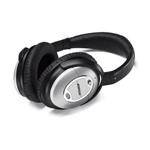 Bose® QuietComfort® 2 Acoustic Noise Cancelling® Headphones: MSRP $299 - Buy Now
Bose® QuietComfort® 2 Acoustic Noise Cancelling® Headphones: MSRP $299 - Buy Now
If you really want to thank the real innovator and pioneer of noise cancellation technology, thank Bose. Lastly, don't let the allure of the higher numbered QuietComfort 3 distract you from the real treat. The QuietComfort 2, in my opinion at least, sound better than the newer QuietComfort. These are a closed ear design which helps further isolate noise without cranking up the active cancellation. While they may make your ears a little warm after a while, it pays off by giving you a more comfortable listening experience after hours of continuous use. Of course, expect that Bose price tag...
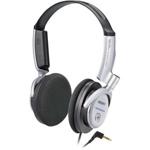 Sony MDR-NC6 Noise Canceling Headphones: MSRP $79 - Buy Now
Sony MDR-NC6 Noise Canceling Headphones: MSRP $79 - Buy Now
Sony's can't sit idly buy, and in true Sony form throws out a reasonably priced and solid contender for your listening pleasure. The MDR-NC6 offers good sound quality all the way around, and surprisingly when the active noise cancellation is turned on or off. Battery life is solid, and the noise cancellation does an adequate job of reducing most unwanted noise. The only downsides: I think they could have gone through another style revision before going out the door, and the comfort could be a tad better.
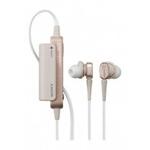 Sony MDRNC22/PIN Noise Canceling Earbuds: MSRP $119 - Buy Now
Sony MDRNC22/PIN Noise Canceling Earbuds: MSRP $119 - Buy Now
Don't like headband style headphones, but still want noise cancellation? No problem, Sony has you covered there, too with their MDRNC22 Noise Cancelling Earbuds. These babies pack in a lot of value: the noise cancellation works well, they come with different sized buds for different sized ears, and they produce exceptional sound with noise cancellation both on and off. The only drawbacks: the battery pack makes them a bit bulkier to carry around than your typical fare of earbuds, and the performance and comfort is pretty reliant on one of the supplied bud sizes fitting your ear. If it doesn't, they won't work as well.
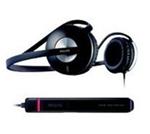 Philips SHN5500/37 Noise Canceling Behind-The-Head Headphone: MSRP $49.99 - Buy Now
Philips SHN5500/37 Noise Canceling Behind-The-Head Headphone: MSRP $49.99 - Buy Now
I actually own an older model of these (which I used for some time before I got my Sennheisers), and will say that when on sale (which is often) provide decent sound quality, good noise cancellation, and good comfort for the price. Philips' noise cancellation design is a tad noisier than similar designs from Sony and Sennheiser, but not bad enough to notice when listening at moderate levels. Sound quality could be better, particularly in the mid-high frequencies and low bass. They are quite comfortable, and for certain things, the behind the head design is preferable to a band style. Despite their shortcomings, at the price you can find them for in stores, they're an excellent value and a good choice for getting your feet wet in noise cancelling headphones without spending tons of dough.
There are plenty of other great noise cancelling headphones out there. Share your experience with the community and tell use what your favorite pair is?





Comments
As a licensed pilot since
As a licensed pilot since 1963, and having flown noisy equipment such as helicopters for 25+ years, and being an active pistol and rifle shooting coach, not to mention marrying into a loud-talking family, noise cancelling headsets are very attractive.
However, not hearing what is going on around the user can be hazardous. Example, taking off in an airplane that suddenly starts making loud, unnatural noises which are not even heard is a one-way ticket to the hospital, or much worse.
Think seriously about how these great inventions will be used. (Outside the home)